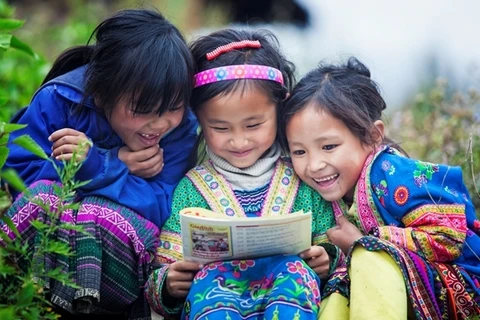Hanoi (VNA) - The prolonged COVID-19 pandemic has exerted a negative impact on the economy for impoverished families in Vietnam. Children are the most vulnerable group in need of protection. Many children have become orphans, homeless or subjected to other long-term consequences now that the pandemic has taken full hold. These problems are likely to increase the number of child laborers because of the COVID-19 pandemic.
Increased risk of child labor after COVID-19
Assessing the impact of the COVID-19 pandemic on children, the Ministry of Labor, War Invalids and Social Affairs reported that the country has nearly 4,500 orphans due to COVID-19. The pandemic also affects children in many ways. It threatens their safety, physical and mental health, and nutrition, disrupting learning and increasing access inequality. It is harder to get a proper education, and the pandemic affects the caring and upbringing of children, limiting entertainment and social communication with peers.
Poverty-stricken families are likely to need children to help work to make money for the family, which impacts their time for education and playtime with peers. In addition, the suspension of school and the extension of virtual learning has imposed great impact on the quality of learning. This is also the reason why the rate of children dropping out of school after the COVID-19 pandemic is likely to increase. Those from a disadvantaged background are particularly susceptible, living in remote, isolated, and ethnic minority areas. Limits in internet access and computer screens also impact these kids.
The increased risk of child labor after the COVID-19 pandemic not only takes place in Vietnam but also is a common problem of many countries around the globe. According to a new study of the International Labor Organization (ILO), while progress on eliminating child labor has stalled since 2016, the impact of the COVID-19 pandemic is presenting bigger obstacles as to the increasing risk of child labor.
According to the ILO statistics, more than 160 million children worldwide (one in 10 children aged 5-17 are still engaged in child labor. It is estimated that without proper mitigation strategies, the number of children in child labor could rise by 8.9 million by the end of 2022, due to higher poverty and increased vulnerability.
ILO experts warned that if policymakers do not act decisively, such factors as the COVID-19 pandemic, ongoing conflict, rising poverty, and climate change will only increase the prevalence of child labor.
Subsidies needed
According to a new report entitled “The role of social protection in the elimination of child labor: Evidence review and policy implications” released by the ILO and the United Nations Children's Fund (UNICEF), social protection reduces family poverty and vulnerability, thereby diminishing key drivers of child labor.
“There are many reasons to invest in universal social protection but eliminating child labor has to be one of the most compelling, given its pernicious impact on children’s rights and wellbeing,” said Guy Ryder, ILO Director-General.
Ensuring that the design of social protection programs is inclusive and child-labor sensitive will help maximize child labor reduction, according to the ILO. Accordingly, countries need to implement child and family benefits that reach all households with children, especially those in situations of greatest vulnerability.
Social protection policies that help families cope with economic or health shocks will make an important contribution to reducing child labor and enabling children to attend school. Therefore, governments need to develop a number of policies to promote social protection, with emphasis on child care and protection, the ILO recommended./.























